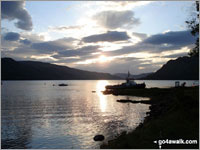Night Time Navigation
 Dusk over Loch Duich from Kintail Lodge (Hotel) near Shiel Bridge, Glen Affric to Kintail, Highland, Scotland
Dusk over Loch Duich from Kintail Lodge (Hotel) near Shiel Bridge, Glen Affric to Kintail, Highland, Scotland
Photo: Chris Haselden
Navigation at night needs practice.
It is more or less the same as daytime navigating in bad visibility, and sometimes can be much easier. However, hill fog plus darkness is very challenging.
A good head torch with a focusable beam is a great advantage for spotting features a little way off. LED head torches give a nice all-round blue light and lack of bulbs make them potentially more reliable but despite claims of 150 hours light, in practice, for night walking, the effective use of new batteries may be more like 15 hours.
Studying the map using strong torchlight for any length of time may damage your night vision for up to an hour. Night vision without torchlight can be surprisingly good though the amount of light varies from night to night. Generally, moonlit nights and cloudy/snowy nights with reflected distant streetlights can be light enough to walk by without a torch.
So don't be scared to turn the torches off for a while and find out how much you can see.
Targets selected after dark should be bigger and more easily identifiable than those chosen in daylight and each Target should also be closer to each other than normal daylight Targets.
Full use of Line Features should be made where possible - with the proviso that following Line Features such as streams steeply downhill in rocky mountainous areas will often lead into difficult or dangerous ground. So if you’re intending to follow a stream at night, the map should be studied very very carefully and all steep ground, waterfalls, gullies and crags noted and given a very wide berth.Wherever possible, it is probably best to try to stick to good paths and tracks.
For some more tips about walking in the dark - click here.




















